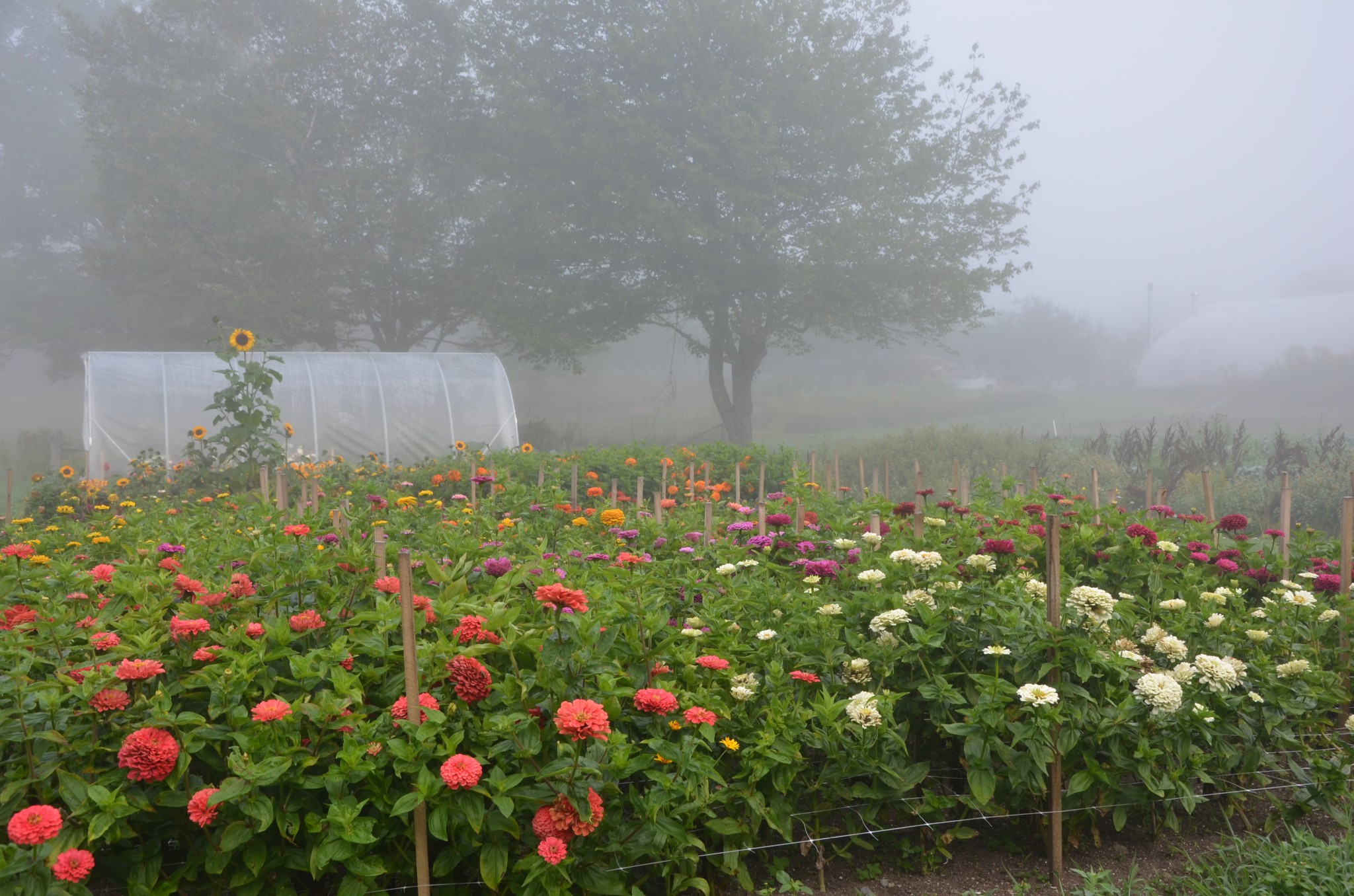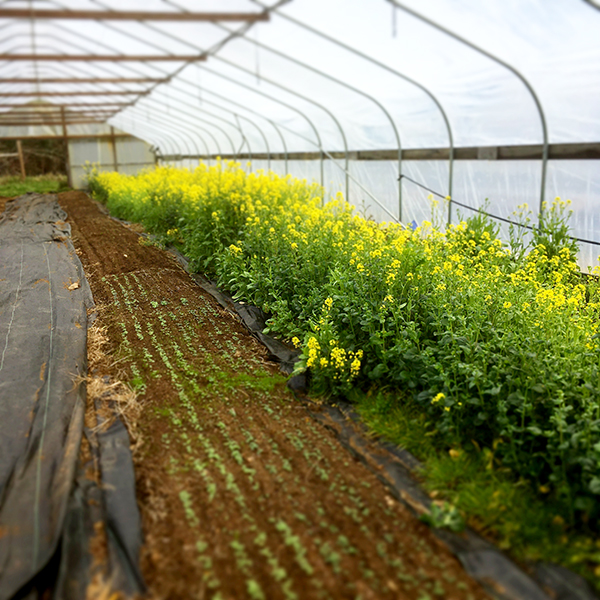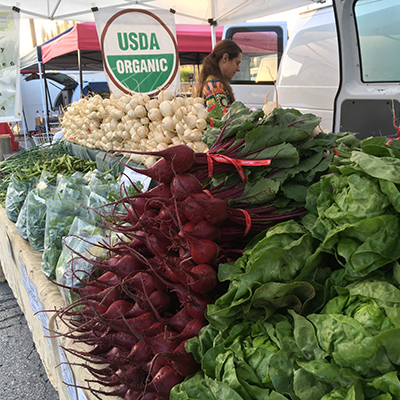Since its founding in 1968 by my husband Eliot Coleman, Four Season Farm has sought to produce the best vegetables possible, using soil-based organic methods, on a small amount of land. When I showed up in 1991, Eliot had begun to pioneer winter vegetable production, and I was delighted to give up the landscape design business I’d run in Connecticut and grow veggies with him. Then, about 10 years ago, flowers started to creep in.
As the farm’s name implies, we do grow some produce in the summer months, though our focus is supplying hardy year-round Mainers with fresh winter food. A summer flower crop dovetails perfectly with that plan. In July and August our area swarms with eager summer customers. And since we maintain a summer crew to grow crops for winter storage and specialty items like artichokes, flower sales help pay those salaries.
Flowers make a good addition to any small farm. They increase plant diversity and attract pollinators. They give an extra measure of beauty to a farm stand or market booth. And in my case, they provide a part of the farm that is mine to tend. Initially, flowers can cause friction. Some vegetable growers have a prejudice against ornamental crops, or a belief that edibles should be able make it on their own. The answer to them is, “Get over it!” And they do.
Sharing physical space with vegetables has its plusses and minuses too. On the good side, a whole farm infrastructure is already in place. But the flower grower may have to negotiate access to fields, greenhouses, tractors, irrigation equipment and even workers’ time. It takes patience, but it can be done. On our farm I’m assured of a 50-foot greenhouse and several outdoor growing areas, along with use of the propagation greenhouse, walk-in cooler and part of a root cellar for dahlia storage. But I keep my own personal tools at our house, which is on the property, and I bunch all my flowers there.
I’ve always been fascinated with articles about flower farms in Growing for Market. They show me what it would be like to scale up my business. To hire my own crew would force me to raise the flower output to a level I wouldn’t enjoy as much, just to equal the profit that I make now. Currently, the only regular expenses I incur, apart from the seed-starting mix, compost and mulch hay I mooch from the farm, are a few dozen seed packets, 18-ounce plastic cups to hold the bouquets, and my time – which I arrange in a way that suits me.
I also sense that my product would become more standardized, and that I might not enjoy it as much as I do now. Presently, in our area, there is enthusiasm for affordable, one-of-a-kind bouquets, and that is what I like to make. They’ve sold well at our on-site farm stand (when we have opened it) and at farmers markets (in years when we have gone to them). The trick is to place bouquets at the point of sale, for a last minute purchase. They also sell very well at two businesses we wholesale them to, one a food co-op and one a nursery with a small food market. In fact last year I earned more supplying those two accounts than I have in past years with retail included as well.
Below, flowers at the point of sale at a farmers market with the mobile farm stand. All images courtesy of Barbara Damrosch.

There are always some special orders, both for custom bouquets and for buckets of flowers for brides and hostesses to arrange themselves. But I’m not interested in “doing weddings” and the complexity that entails. My goal is to continually streamline the business, growing better and better flowers but more efficiently, and raising prices a bit, now that I’ve built up a steady demand.
I’ve been growing the flowers the same way we grow our other crops, in 30-inch-wide beds with 12-inch paths between them. Eliot sometimes forms beds for me, by setting the wheels of a tractor the perfect distance apart and driving it down the field to define the paths. But the paths have proved too narrow for most of the bushy plants I grow, so I’m planning to widen both beds and paths this coming year.
Most of the annuals I grow need support to keep them upright, not just for tidy, navigable beds but because stems that have flopped and then turned up at the tip are unusable. I use horizontal plastic Hortonova, sometimes two levels for tall guys like larkspur, supported by 4-foot grade stakes. Both are reusable, for a while, but I might give metal posts a try.
I mulch the beds with spoiled hay, usually bales bought from a nearby farmer, since I prefer a mulch that can be tilled under in fall to improve the soil. We cultivate our vegetable beds with light, skimming hoes to get weeds while they are tiny, but this is difficult after flower netting is in place. We also use a backpack flame weeder to produce seed-free beds for planting, but it’s cumbersome, and I’m waiting for Eliot to design a wheeled, bed-sized model.
Some of the author's outdoor flower beds. Hortonova netting is attached to the wooden stakes to keep the flowers upright.

Because the farm is in midcoast Maine, a half mile from the ocean, our springs are cold and our summers cool. It takes a long time for the water to warm up, though once it does, it holds enough heat to give the land a warm fall. Annuals take a long time to get going, so I’m lucky to have the heated propagation house to start them in, as well as a heated space in which I can divide and pot up dahlias to give them a head start. Transplanting all these starts into my unheated, moveable flower house gains several precious weeks of early bloom. Using soil blockers from Johnny’s Selected Seeds gives me super-healthy starts, too, with no transplant shock. I’ll have that greenhouse until mid-November, when it’ll slide over leeks or spinach, so I get a little extra time in fall too. The greenhouse flowers are grown just like my outdoor ones, except that they’re watered overhead with Netafim sprinklers rather than the Wobbler sprinklers mounted on metal stands that we use outdoors. Those spin around making heavy droplets that aren’t blown away by wind.
Efficiency is also gained by fine-tuning the amounts of each variety I grow and sowing succession plantings as needed. Making the most of the space reduces upkeep. I’m always looking for better varieties, with great colors, improved vase life and longer, stronger stems.
What I grow is determined partly by the kind of bouquets I make: compact, easy to display, and easy for the customer to take home. They’re bunches, not flowing, free-form arrangements. But they still can be interesting, and I put lots of thought into having a wide range of colors, textures and shapes. I look for good blending colors - such as pale yellow, lavender, salmon and lime - that tie together the pinky-blue-purple range with the scarlet-yellow orange one. I like flowers that are unusual in some way. The near-black shade found in some dahlias, scabiosas and tulips is great for dramatic contrast. People are amused by the little yellow balls of Craspedia, won over by the elegant lace of white Orlaya, or pale blue Didiscus, and intrigued with Daucus carota ‘Dara’ a multihued carrot blossom that doesn’t droop.
The author’s bunches in the cups used to keep them hydrated, packed in the wooden box used for transport.

My mainstays are dahlias and zinnias. For the dahlias I propagate a wide range of colors, stockpiling the workhorses, such as the sunset-colored Pam Howden, blazing Patricia Ann’s Sunset and basic white Blizzard, and adding some new ones each year. For zinnias I count on the Benary’s Giant series, in all the colors. Other dependables include Ageratum Blue Planet, Celosia Pampas Plume, Snapdragon Potomac Custom Mix, Larkspur Sublime Formula Mix, Salvia Gruppenblau, Scabiosa Pincushion Formula Mix, Rudbeckia Goldilocks and Prairie Sun, Verbena bonariensis, Centaurea Florist Blue Boy, and Statice Midnight Blue. I get these from Johnny’s, but go elsewhere for blue Salvia horminum, in blue only. The only separately-bunched flowers I sell are sweet peas, lavender and sunflowers (ProCut Orange, Gold and Lemon, Vincent’s Choice and Soraya).
Annuals are only half the story. The other half involves the home landscape. The first flowers in March are mixed narcissus from a small glasshouse that adjoins our house, warmed a bit by two freezers in our utility room when the door between the two is left open. About the time that outdoor narcissus bloom, tulips in the glasshouse join in. To bulb bouquets I add the tips of four outdoor shrubs -- black pussy willow (Salix gracilistylus Melanostachys) vernal witch hazel (Hamamelis vernalis), mountain laurel (Kalmia latifolia) and mountain andromeda (Pieris floribunda). The last is hard to find, but I aim to try the hybrid Brower’s Beauty for hardiness. I snip the young foliage of my Katsura japonica trees too.
Once we’re into outdoor bulbs in April and May, it’s a challenge to make it to peony bloom, which can be late June. I thank myself for planting overambitious perennial gardens in 2002, including two big borders, a rose garden, a white garden and a shade garden underneath a grape allée. Sissinghurst they are not, but I rob them mercilessly for Pulmonaria, Trollius, and Geum, and am still trialing new earlies for pickability. Allium aflatuense Purple Sensation, which, like all my bulbs, I buy from Van Engelen, is a savior, its color best when just beginning to open. Soon there are perennial geraniums, Doronicum, Centaurea, Aruncus dioicus and columbines. And just when the late parrot and viridiflora tulips give out, and I’m dolefully squeezing the hard peony buds, the first wild lupines, on a steep south-facing bank, explode. When peonies open, I mix them with Alchemilla, Nepeta, Salvia May Night, the wonderful Aconitum anthora and blue Baptisia australis, which resembles a lupine but doesn’t contort its spike when cut. I give thanks to a terribly weedy purple-leaved thing (Lysimachia ciliata?), which yields great filler from late spring on.
Bouquets for sale bring a burst of color to the farmstand.

Annuals barely overlap with peonies, but after that the home garden is more or less spared, except for the occasional theft of Astilbe, Cimicifuga, Artemisia lactiflora, Joe Pye weed, Kierengeshoma palmata, Thalictrum Lavender Mist, late phlox and asters.
But throughout flower season, the wild landscape of the farm comes into play, adding a personal dimension to the bouquets. I’ve used the blossoms of red maple, and two of my favorite spiky elements: the white, shrubby meadowsweet (Spiraea alba latifolia) and the pink steeplebush (Spiraea tomentosa). A half dozen or so goldenrod species unfold throughout summer and fall. I substitute little gold buttons of wild tansy for people who think, mistakenly, that goldenrod makes them sneeze.
Maintenance includes deadheading (especially zinnias) and snipping large weeds that sneak up on me by cutting them at ground level. Harvest takes place three times a week during the busy months, more often if the farm stand is open. I use needle nose shears, strip stems in the field, and put them into water-filled quart-sized yogurt containers, three to a small, flared plastic bucket -- then off to the cooler until all are picked.
I arrange bouquets by laying them out at the house on long tables, starting with primary flowers like peonies, dahlias and lilies, followed by zinnias and the rest, and ending with blue accents and filler. If I run out, the garden is right out the back door.
Two weekday flower deliveries, along with eggs and some wholesale vegetables, are made by the crew in our farm van. I make a smaller Saturday delivery in my roomy hatchback. Thanks to the acidity of our farm’s water, I seem to get by without preservatives. I urge the stores to change the water in the cups often, and place them where they’ll be noticed. I set managers up with our wooden boxes, topped with notched boards into which holes have been cut to support the plastic cups, in which customers can take the bouquets home. Ultimately, the most important thing is to make those bouquets - so satisfying to create - too appealing to refuse.
A closeup of the boxes the author uses to hold 18-ounce plastic cups to transport bunches of flowers for sale.

Barbara Damrosch is the author of three gardening books, including The Garden Primer and The Four Season Farm Gardener’s Cookbook (co-authored with Eliot). For the past fourteen years she has written A Cook’s Garden, a weekly column about growing edibles for The Washington Post. It is syndicated in other papers around the country.


 Here's a system to track all those details
Here's a system to track all those details

 If you’ve been a subscriber to Growing For Market (or even if you haven’t), you’re probably familiar with the many advantages of no-till agriculture. No-till methods can reduce a farm’s carbon footprint, promote complex soil biology, and preserve and build organic matter.
If you’ve been a subscriber to Growing For Market (or even if you haven’t), you’re probably familiar with the many advantages of no-till agriculture. No-till methods can reduce a farm’s carbon footprint, promote complex soil biology, and preserve and build organic matter.



 For most established growers, the easiest place to start selling flowers will be mixed bouquets and single stem/small bunch retail sales. These are the flowers you can sell to your existing customers and they are easy to incorporate into farmers market, CSA, and grocery sales. But there are lots of other outlets out there, including florists, weddings and events, business subscriptions, value added products, and wholesalers.
For most established growers, the easiest place to start selling flowers will be mixed bouquets and single stem/small bunch retail sales. These are the flowers you can sell to your existing customers and they are easy to incorporate into farmers market, CSA, and grocery sales. But there are lots of other outlets out there, including florists, weddings and events, business subscriptions, value added products, and wholesalers.








 Sisters grow native perennials in Florida and New York
Sisters grow native perennials in Florida and New York